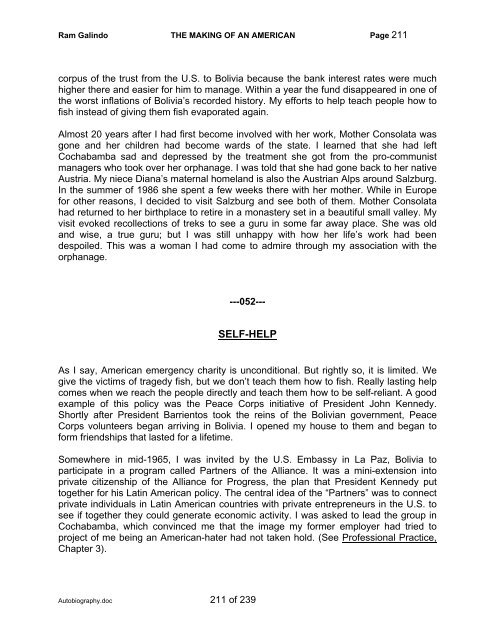Autobiography - The Galindo Group
Autobiography - The Galindo Group
Autobiography - The Galindo Group
You also want an ePaper? Increase the reach of your titles
YUMPU automatically turns print PDFs into web optimized ePapers that Google loves.
Ram <strong>Galindo</strong> THE MAKING OF AN AMERICAN Page 211<br />
corpus of the trust from the U.S. to Bolivia because the bank interest rates were much<br />
higher there and easier for him to manage. Within a year the fund disappeared in one of<br />
the worst inflations of Bolivia’s recorded history. My efforts to help teach people how to<br />
fish instead of giving them fish evaporated again.<br />
Almost 20 years after I had first become involved with her work, Mother Consolata was<br />
gone and her children had become wards of the state. I learned that she had left<br />
Cochabamba sad and depressed by the treatment she got from the pro-communist<br />
managers who took over her orphanage. I was told that she had gone back to her native<br />
Austria. My niece Diana’s maternal homeland is also the Austrian Alps around Salzburg.<br />
In the summer of 1986 she spent a few weeks there with her mother. While in Europe<br />
for other reasons, I decided to visit Salzburg and see both of them. Mother Consolata<br />
had returned to her birthplace to retire in a monastery set in a beautiful small valley. My<br />
visit evoked recollections of treks to see a guru in some far away place. She was old<br />
and wise, a true guru; but I was still unhappy with how her life’s work had been<br />
despoiled. This was a woman I had come to admire through my association with the<br />
orphanage.<br />
---052---<br />
SELF-HELP<br />
As I say, American emergency charity is unconditional. But rightly so, it is limited. We<br />
give the victims of tragedy fish, but we don’t teach them how to fish. Really lasting help<br />
comes when we reach the people directly and teach them how to be self-reliant. A good<br />
example of this policy was the Peace Corps initiative of President John Kennedy.<br />
Shortly after President Barrientos took the reins of the Bolivian government, Peace<br />
Corps volunteers began arriving in Bolivia. I opened my house to them and began to<br />
form friendships that lasted for a lifetime.<br />
Somewhere in mid-1965, I was invited by the U.S. Embassy in La Paz, Bolivia to<br />
participate in a program called Partners of the Alliance. It was a mini-extension into<br />
private citizenship of the Alliance for Progress, the plan that President Kennedy put<br />
together for his Latin American policy. <strong>The</strong> central idea of the “Partners” was to connect<br />
private individuals in Latin American countries with private entrepreneurs in the U.S. to<br />
see if together they could generate economic activity. I was asked to lead the group in<br />
Cochabamba, which convinced me that the image my former employer had tried to<br />
project of me being an American-hater had not taken hold. (See Professional Practice,<br />
Chapter 3).<br />
<strong>Autobiography</strong>.doc 211 of 239


